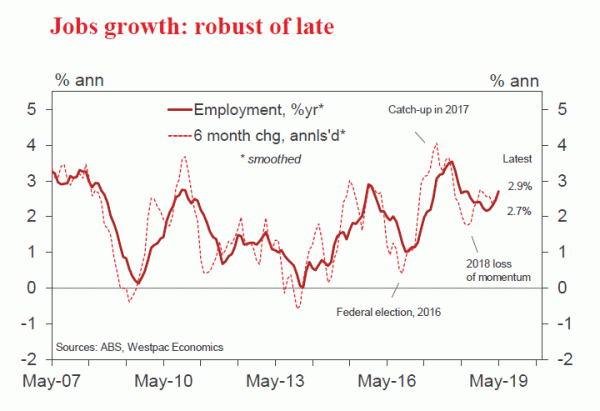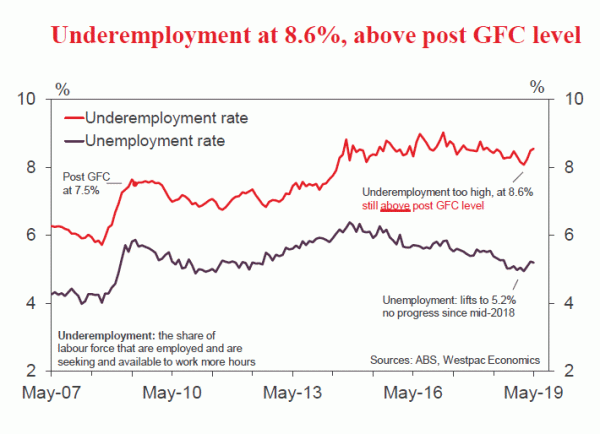For May, a mixed set of results.
Hours worked, weakened, down by -0.3%. The unemployment rate held steady at 5.2%, while the underemployment rate rose further, to 8.6%.
Employment, exceeded expectations, up 42.3k, largely parttime, +39.8k. Employment by state was: NSW, +38.5k; Vic +28.6k; Qld +7.8k; SA, +4.4k; WA -4.0k, Tas -0.4k. In addition, employment for April was revised up, to +43.1k from +28.4k.
Comments
As noted above, employment gains exceeded expectations, +42.3k v’s market median +16k and Westpac +5k. However, hours worked weakened, contracting by 0.3% in the month. We’d note that if the lift in jobs in May was largely a spike associated with people working on the May 18 Federal election, it would be reasonable to expect hours worked to strengthen, not weaken.
The unemployment rate disappointed, holding steady at 5.2%, vs market median 5.1% and Westpac 5.2%. Unemployment has drifted higher in 2019, up from 5.0% at the start of the year. During 2018, some progress was made in reducing the unemployment rate, from 5.5% to 5.0% by September.
The labour supply is proving to be quite responsive, with the participation rate rising to a fresh record high. The participation rate climbed to 66.0%, up from 65.9% in April and from 65.7% in March.
This underscores that there is still considerable slack in the labour market.
Adding weight to this view, the underemployment rate now appears to be trending higher, rising to 8.6%, up from 8.5% in April and up from a low of 8.1% in February. This is back to the levels prevailing over the second half of 2017.
These mixed results may, in part, be due to sample rotation issues. The ABS notes that “In original terms, the incoming rotation group in May 2019 had a higher employment to population ratio than the group it replaced (64.0% in May, compared to 62.3% in April 2019), and was higher than the ratio for the entire sample (62.9%).”
For now, jobs growth momentum remains robust. Employment is 2.9% higher than a year ago, with full-time employment up by 3.1% and part-time some 2.4% higher. Over the past six months, jobs growth is 2.7% annualised.
Looking ahead, we see the risk that jobs momentum slows, consistent with the weakening of domestic demand. In the year to mid-2018, domestic demand grew by a robust 3.2%, moderating to a 1.8% annualised pace over the second half of the year, and then slumping to only a 0.6% annualised pace in the opening quarter of 2019.
For the RBA, more needs to be done to bring the unemployment rate down and closer to 4.5%, or below, in order to gain some traction on lifting wages growth to a more sustainable path.

















